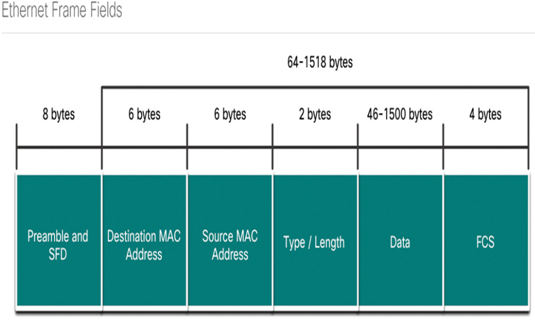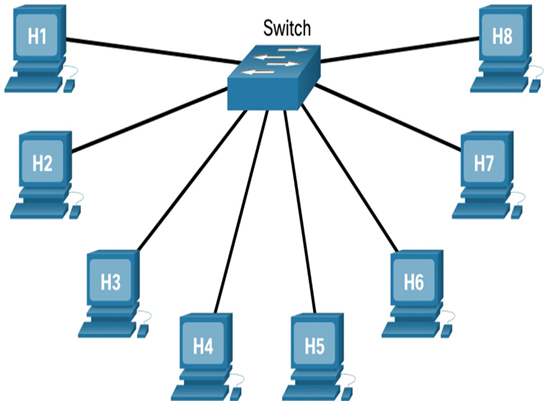The access layer describes the network components used to provide an end device access to the network and the LAN.
The Ethernet protocol standards define many aspects of network communication including frame format, frame size, timing, and encoding.
When messages are sent between hosts on an Ethernet network, the hosts format the messages into the frame layout that is specified by the standards. Frames are also referred to as Layer 2 protocol data units (PDUs). This is because the protocols that provide the rules for the creation and format of the frame perform the functions that are specified at the data link layer (Layer 2) of the OSI model.
The format, shown in Figure 7-3, for Ethernet frames specifies the location of the destination and source MAC addresses, and additional information including:
• Preamble for sequencing and timing
• Start of frame delimiter
• Length and type of frame
• Frame check sequence to detect transmission errors
The size of Ethernet frames is normally limited to a maximum of 1518 bytes and a minimum size of 64 bytes from the Destination MAC Address field through the Frame Check Sequence (FCS). The preamble and the Start of Frame Delimiter (SFD) are used to indicate the beginning of the frame. They are not used in the calculation of the frame size. Frames that do not match these limits are not processed by the receiving hosts. In addition to the frame formats, sizes and timing, Ethernet standards define how the bits making up the frames are encoded onto the channel. Bits are transmitted as either electrical impulses over copper cable or as light impulses over fiber-optic cable.

Figure 7-3 Ethernet Frame Structure and Field Size
The access layer is the basic level of the network. It is the part of the network in which people gain access to other hosts and to shared files and printers. The access layer provides the first line of networking devices that connect hosts to the wired Ethernet network.
Networking devices enable us to connect many hosts with each other and also provide those hosts access to services offered over the network. Unlike the simple network consisting of two hosts connected by a single cable, in the access layer, each host is connected to a networking device. This type of connectivity is shown in Figure 7-4.
Within an Ethernet network, each host is able to connect directly to an access layer networking device using an Ethernet cable. These cables are manufactured to meet specific Ethernet standards. Each cable is plugged into a host NIC and then into a port on the networking device. There are several types of networking devices that can be used to connect hosts at the access layer, including Ethernet switches.

Figure 7-4 Multiple Hosts Connected to a Networking Device
